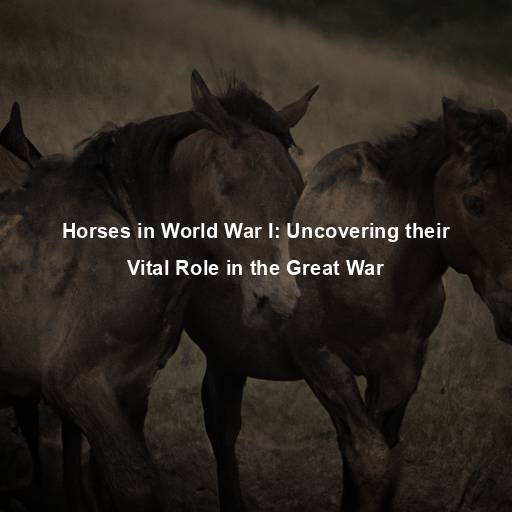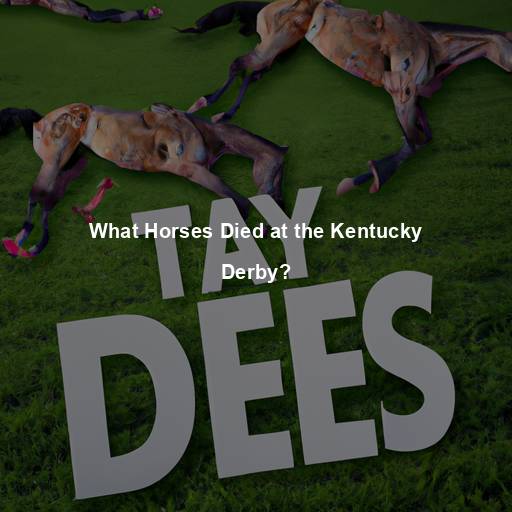Horses in World War I: Uncovering their Vital Role in the Great War
Last Updated on July 10, 2023 by Evan
In the dramatic and unpredictable theater of World War I, a surprising protagonist emerged – the horse. Amidst the chaos and confusion of battle, these noble creatures took on an unprecedented role. From carrying our brave soldiers into the heart of conflict to easing the burden of vital supplies, the horse became an invaluable asset on the front lines. Despite the ever-evolving nature of warfare, with its mechanized weapons and shifting strategies, one thing remained constant – the unwavering loyalty and untamed courage of these equine warriors.
The cataclysmic eruption of World War I in 1914 changed the course of warfare forever, bringing forth a deluge of bewilderment and chaos. Amidst the bewildering tempest of battle, it was the humble steed that emerged as a paradoxical savior, raising eyebrows and leaving historians grappling with its enigmatic significance. In this captivating piece, we dare to unravel the intricate tapestry of the equine catalysts that shaped the early chapters of this devastating conflict. Prepare to be enthralled as we unveil the myriad roles, challenges, and enduring legacy of these enigmatic creatures.
Contents
- 1 The Equine Cavalry: A Symbol of Power and Mobility
- 2 Horses on the Front Lines: The Challenges and Perils
- 3 The Unsung Heroes: Horses in Non-Combat Roles
- 4 Legacy and Remembrance: Honoring the Equine Sacrifice
- 5 FAQs – What were horses used for in WW1?
- 5.1 What role did horses play in World War 1?
- 5.2 How many horses were involved in WW1?
- 5.3 Did horses face the same dangers as soldiers in WW1?
- 5.4 How were horses transported to the battlefield?
- 5.5 What happened to the horses after the war?
- 5.6 Were any horse breeds more commonly used in WW1?
- 5.7 Were any horses awarded for their service in WW1?
The Equine Cavalry: A Symbol of Power and Mobility
The Noble Steed: The Backbone of Cavalry Units
During the tumultuous days of World War I, these majestic creatures known as horses galloped into the forefront of warfare, taking on a pivotal role in the esteemed cavalry units. Admired for their untamed agility, lightning-like speed, and uncanny ability to outmaneuver the opposition, these noble beasts brought a sense of awe and unpredictability to the battlefield. With an impressive array of duties ranging from lightning-fast assaults to gathering vital intel behind enemy lines, the cavalry found their salvation in the tireless strength and unwavering loyalty of these four-legged warriors. Their presence on the battlefield was nothing short of essential, swiftly bridging the gaps between fellow soldiers and delivering fatal blows to the heart of the enemy’s defenses.
The Power of Shock and Awe
Cavalry charges were among the most iconic and awe-inspiring spectacles of World War I. The sheer force and momentum of a mounted charge could break enemy lines and instill fear in the hearts of opposition forces. The psychological impact of horses thundering towards the enemy was immeasurable, often causing soldiers to panic or retreat. These charges were not only tactical maneuvers but also powerful symbols of dominance and power on the battlefield.
Horses on the Front Lines: The Challenges and Perils
A Brutal Clash of Old and New
While horses were undeniably effective on the battlefield, they faced significant challenges in the face of modern warfare. The introduction of machine guns, artillery, and trench warfare presented a deadly combination. The clash between traditional cavalry tactics and modern weaponry was often disastrous for the horses and their riders. The once-glorified cavalry charges turned into futile and devastating endeavors, as soldiers and equines alike were mowed down by relentless gunfire.
Living Conditions and Battlefield Hazards
During the tumultuous era of World War I, the living conditions of our loyal equine companions became a subject of utmost concern. Amidst the chaos and uncertainty, these gallant creatures found themselves battling not just the harsh weather and limited sustenance, but also the scarcity of vital medical care. In the unforgiving trenches, meant primarily for human warriors, these majestic creatures faced the perils of shellfire, treacherous wire entanglements, and the dreaded specter of equine influenza. These formidable challenges weighed heavily on the well-being of these valiant horses, further muddling the already intricate dynamics of their crucial role in the war effort.
The Unsung Heroes: Horses in Non-Combat Roles
Hauling Supplies and Artillery
When the world was consumed by the chaos of World War I, one often wonders who carried the burden of supplying the front lines. Amidst the trenches and the turmoil, horses emerged as the unsung heroes, bravely navigating treacherous terrains, bearing the weight of supplies, ammunition, and even heavy artillery. With every cautious step they took, they defied both enemy fire and exhaustion, ensuring that the forces had the sustenance they needed to persevere. Their tenacity and endurance became the lifeline that sustained the war effort, embodying the invaluable partnership between man and beast in times of great perplexity.
Medical Support and Ambulance Duties
In the chaos of war, horses emerged as superheroes on the battlefield, extending their noble duties to the realm of medicine. Bravely charging through hazardous terrains, these awe-inspiring animals became the guardians of life, transporting wounded soldiers amidst bullets and chaos. With unwavering determination, they forged paths of hope, offering solace to the injured on their arduous voyage towards life-saving medical aid. Their unwavering presence lent an air of courage and solace, forever etching their hoofprints in the annals of wartime heroism.
Legacy and Remembrance: Honoring the Equine Sacrifice
The End of an Era
As the battlefields transformed and war moved forward, it became clear that horses were losing their place in the fray. The rise of tanks and mechanized transport pushed cavalry charges out of the picture, signaling the end of the era where horses ruled the warfront. Yet, amidst this perplexing shift, one thing remained certain – the enduring legacy of these majestic beings, their bravery, loyalty, and indomitable spirit would forever be intertwined with the pages of history.
Reverence and Commemoration
From the towering monuments to the somber memorials, the world bears witness to the indomitable spirit of the horses who gallantly served in the Great War. Their sacrifices, untold stories, and unwavering loyalty weave a profound narrative that transcends time and touches the deepest recesses of our collective memory. These monuments, carved in stone and enshrined in history, are symbols of awe-inspiring bravery, binding connections, and a testament to the enduring power of the human-animal bond. As we stand before these commemorative masterpieces, we are confronted with a surge of emotions, an enigmatic mix of gratitude, reverence, and a resolute desire to never forget the invaluable contributions that these majestic creatures made on the battlefield.
FAQs – What were horses used for in WW1?
What role did horses play in World War 1?
The immense significance of horses during World War 1 cannot be understated, as they took on multifaceted roles that showcased their sheer versatility and indispensability. From being noble mounts for cavalry regiments, charging fearlessly into the fog of war, to tirelessly pulling heavy artillery units across treacherous terrains, these magnificent creatures proved time and again their unwavering strength and loyalty. Moreover, their significance extended beyond the battlefield, with their ability to transport vital supplies and brave messengers carrying crucial messages amidst chaos and confusion. The horses’ valiant contribution to the war effort remains an awe-inspiring testament to their undeniable resilience and unwavering commitment amidst the turmoil-infused theater of war.
How many horses were involved in WW1?
World War 1 witnessed an astonishing utilization of approximately eight million horses, sourced from diverse nations embroiled in the conflict. This unfathomable demand for equine companions engulfed the battlefields across the Western and Eastern Fronts, the Middle Eastern deserts, and other theatres of war. The perplexing reliance on these noble creatures resonates as a testament to the entangled unpredictability that characterized this tumultuous period in history.
Did horses face the same dangers as soldiers in WW1?
During the tumultuous era of World War 1, horses gallantly shared the battlefield with soldiers, weaving an intricate tapestry of bravery and hardship. Amidst the cacophony of artillery fire and relentless machine gun attacks, these noble creatures bore witness to the horrors of chemical warfare, standing tall amidst chaos and confusion. However, they were not exempt from the clutches of tragedy, as they too fell victim to grave injuries and fatal diseases, a consequence of the unforgiving nature of war. Unyielding in their resilience, horses faced the brutalities of trench warfare with unwavering courage, navigating precarious terrains and confronting dangers that perplexed their very existence.
How were horses transported to the battlefield?
In the grand theater of war, horses were ferried to the frontlines, their majestic presence carried upon the iron veins of the railway. These gallant creatures, stalwart companions in battle, were thoughtfully entrusted to specialized wagons and train cars, fashioned exclusively to cradle their noble frames. Yet, at times, the cruel hand of destiny forced them to embark on arduous journeys, traversing vast expanses on their own four hooves, until the distant echoes of war drew near. Then, with a graceful release from their temporary confines, they would gallop forth to fulfill their purpose amidst the turmoil and chaos of battle.
What happened to the horses after the war?
In the tumultuous wake of World War 1, the fate of countless valiant equine companions was shrouded in an enigmatic haze of uncertainty. Amidst the chaos of battle, a harrowing ballet of equine demise unfolded; horses valiantly charging forward, their lives tragically truncated by war’s relentless grasp. In the aftermath, a convoluted tapestry of destinies emerged: some steeds succumbed to their injuries, others found solace in foreign lands, and a fortuitous few were gracefully ushered back home to reacquaint themselves with a semblance of civilian existence, their hooves finding purpose in the rhythms of agrarian life. A tale of perplexity, where hoofbeats mingled with the echoes of gunfire, and uncertainty cast its inescapable shadow upon these noble creatures.
Were any horse breeds more commonly used in WW1?
No specific breed of horse was exclusively used in World War 1. Various horse breeds and types were employed based on their suitability for particular tasks. Different countries had their preferred breeds, such as the British using many draft horses, while others relied on lighter breeds for cavalry purposes. Overall, a range of breeds including Clydesdales, Percherons, Thoroughbreds, and Arabs were deployed during the war.
Were any horses awarded for their service in WW1?
In the tumultuous landscape of World War 1, where medals glittered like stars, one group of valiant beings remained overlooked and undercelebrated. Yet, their impact was felt deeply by those who fought alongside them – the horses. These unsung heroes of the battlefield garnered not only respect, but a profound sense of affection from the soldiers they served alongside. Braving the chaos and uncertainty, they embodied bravery, loyalty, and sacrifice.







